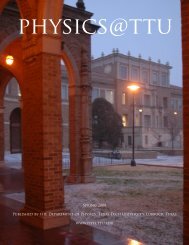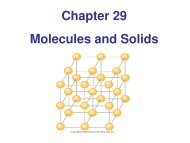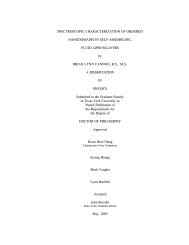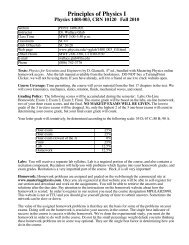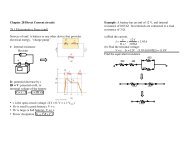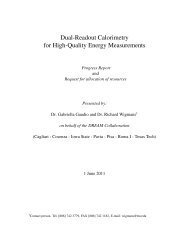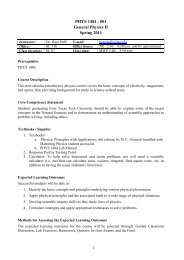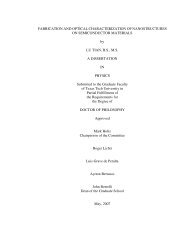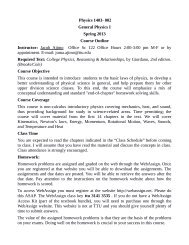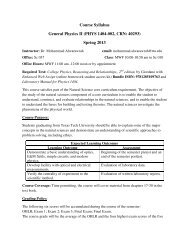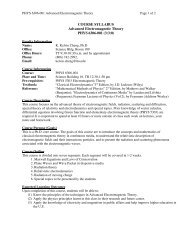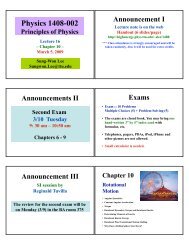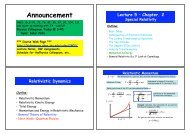Version One â Homework 1 â Juyang Huang â 24018 â Jan 16 ...
Version One â Homework 1 â Juyang Huang â 24018 â Jan 16 ...
Version One â Homework 1 â Juyang Huang â 24018 â Jan 16 ...
Create successful ePaper yourself
Turn your PDF publications into a flip-book with our unique Google optimized e-Paper software.
<strong>Version</strong> <strong>One</strong> – <strong>Homework</strong> 1 – <strong>Juyang</strong> <strong>Huang</strong> – <strong>24018</strong> – <strong>Jan</strong> <strong>16</strong>, 2008 24<br />
as in Part 1.<br />
The electric field for r < R with the<br />
E =<br />
Q<br />
4 π ɛ 0 r 2 , where R < r , (1) = k Q r ,<br />
R3 where R < r . (3)<br />
sphere conducting: In the region inside The electric field for r < R with the<br />
the conducting sphere, we select a spherical sphere uniformly non-conducting: In<br />
gaussian surface r < R, concentric with the this case we select a spherical gaussian surface<br />
conducting sphere. To apply Gauss’s law<br />
at a radius r where r < R, concentric<br />
in this situation, we realize that there is no with the uniformly charged non-conducting<br />
charge within the gaussian surface (q in = 0), sphere. Let us denote the volume of this<br />
which implies that<br />
sphere by V ′ . To apply Gauss’s law in this<br />
E = 0 , where r < R . (2)<br />
situation, it is important to recognize that the<br />
charge q in within the gaussian surface of the<br />
E ∝ 1 volume V ′ is less than Q. Using the volume<br />
r 2<br />
charge density ρ ≡ Q<br />
E<br />
V , we calculate q in :<br />
Y.<br />
q in = ρ V<br />
( ′<br />
) 4<br />
0 R<br />
r<br />
= ρ<br />
3 π r3 .<br />
048 (part 2 of 4) 10 points<br />
By symmetry, the magnitude of the electric<br />
Which diagram describes the electric field vs<br />
field is constant everywhere on the spherical<br />
radial distance [E(r) function] for a uniformly<br />
gaussian surface and is normal to the surface<br />
charged non-conducting sphere<br />
at each point. Therefore, Gauss’s law in the<br />
1. S correct<br />
2. L<br />
region r < R gives<br />
∮<br />
∮<br />
E dA = E dA<br />
3. X<br />
4. Z<br />
= E ( 4 π r 2) = q in<br />
.<br />
ɛ 0<br />
Solving for E gives<br />
5. G<br />
E =<br />
q in<br />
4 π ɛ 0 r 2<br />
6. Q<br />
ρ 4<br />
7. P<br />
= 3 π r3<br />
4 π ɛ 0 r 2<br />
8. Y<br />
= ρ r .<br />
3 ɛ 0<br />
9. M<br />
Because ρ =<br />
Q (by definition) and since<br />
Explanation:<br />
4<br />
The electric field for R < r with<br />
3 π R3<br />
the sphere conducting and/or uniformly k = 1 , this expression for E can be written<br />
as<br />
non-conducting: In the region outside the 4 π ɛ 0<br />
uniformly charged non-conducting sphere, we<br />
have the same conditions as for the conducting<br />
sphere when applying Gauss’s law, so<br />
E =<br />
Q r<br />
4 π ɛ 0 R 3



